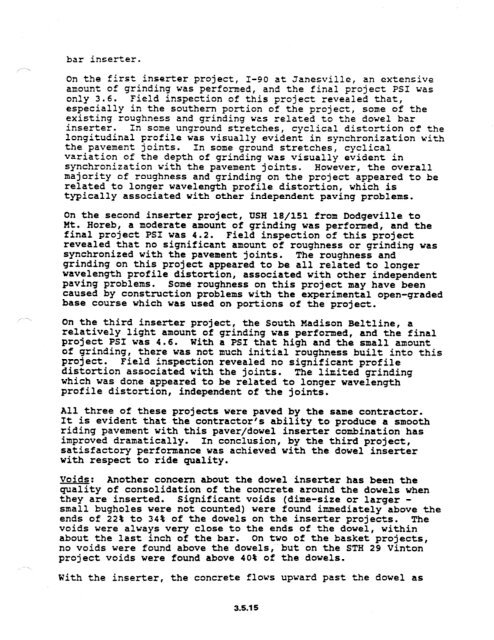chapter 3 rigid pavement - DOT On-Line Publications - Department ...
chapter 3 rigid pavement - DOT On-Line Publications - Department ...
chapter 3 rigid pavement - DOT On-Line Publications - Department ...
You also want an ePaper? Increase the reach of your titles
YUMPU automatically turns print PDFs into web optimized ePapers that Google loves.
ar inserter.<br />
<strong>On</strong> the first inserter project, I-90 at Janesville, an extensive<br />
amount of grinding was performed, and the final project PSI was<br />
only 3.6. Field inspection of this project revealed that,<br />
especially in the southern portion of the project, some of the<br />
existing roughness and grinding was related to the dowel bar<br />
inserter. In some unground stretches, cyclical distortion of the<br />
longitudinal profile was visually evident in synchronization with<br />
the <strong>pavement</strong> joints. In some ground stretches, cyclical<br />
variation of the depth of grinding was visually evident in<br />
synchronization with the <strong>pavement</strong> joints. However, the overall<br />
majority of roughness and grinding on the project appeared to be<br />
related to longer wavelength profile distortion, which is<br />
typically associated with other independent paving problems.<br />
<strong>On</strong> the second inserter project, USH 18/151 from Dodgeville to<br />
Mt. Horeb, a moderate amount of grinding was performed, and the<br />
final project PSI was 4.2. Field inspection of this project<br />
revealed that no significant amount of roughness or grinding was<br />
synchronized with the <strong>pavement</strong> joints. The roughness and<br />
grinding on this project appeared to be all related to longer<br />
wavelength profile distortion, associated with other independent<br />
paving problems.<br />
Some roughness on this project may have been<br />
caused by construction problems with the experimental open-graded<br />
base course which was used on portions of the project.<br />
<strong>On</strong> the third inserter project, the South Madison Beltline, a<br />
relatively light amount of grinding was performed, and the final<br />
project PSI was 4.6. With a PSI that high and the small amount<br />
of grinding, there was not much initial roughness built into this<br />
project. Field inspection revealed no significant profile<br />
distortion associated with the joints. The limited grinding<br />
which was done appeared to be related to longer wavelength<br />
profile distortion, independent of the joints.<br />
All three of these projects were paved by the same contractor.<br />
It is evident that the contractor's ability to produce a smooth<br />
riding <strong>pavement</strong> with this paver/dowel inserter combination has<br />
improved dramatically. In conclusion, by the third project,<br />
satisfactory performance was achieved with the dowel inserter<br />
with respect to ride quality.<br />
Voids: Another concern about the dowel inserter has been the<br />
quality of consolidation of the concrete around the dowels when<br />
they are inserted. Significant voids (dime-size or larger -<br />
small bugholes were not counted) were found immediately above the<br />
ends of 22% to 34% of the dowels on the inserter projects. The<br />
voids were always very close to the ends of the dowel, within<br />
about the last inch of the bar. <strong>On</strong> two of the basket projects,<br />
no voids were found above the dowels, but on the STH 29 Vinton<br />
project voids were found above 40% of the dowels.<br />
With the inserter, the concrete flows upward past the dowel as<br />
3.5.15
















